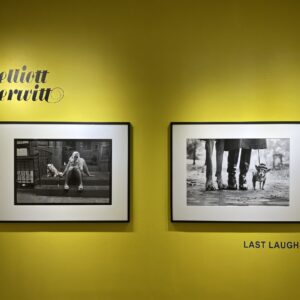JTF (just the facts): Self-published in 2022 (here). Stitched softcover with pink plastic sleeve, 62 pages, with 60 color photographs. Includes an essay by Branislav Štěpánek in Slovak/English. In an edition of 300 copies, with 11 collector’s editions. Design by Matúš Lelovský and the artist. (Cover and spread shots below.)
Comments/Context: Not every photobook announces itself with a hot pink transparent plastic slipcase featuring the title in brash yellow capitals, but Zuzana Pustaiová’s recent photobook One Day Every Day isn’t like most photobooks. It knows it’s being irreverent and provocative, and seems happy to tweak our expectations from the very start.
And almost before we get an unfiltered look at the first image, the glossy cardstock book starts to unfold itself in unexpected ways. Definitionally, we might call One Day Every Day a leporello, with its imagery printed on both sides of continuous accordion folded pages; but actually it’s several separate leporellos stitched together, creating puzzling overlaps, folds, tucks, and page turns that double back on themselves, to the point that it’s hard to know exactly what the “right” progression might be. But this intentional disruption is part and parcel of the fun being offered here, with each potential refolding of the book bringing Pustaiová’s audacious images into dialogue with each other in new ways.
Pustaiová’s photographic style mixes equal parts brightly-lit commercial/editorial brassiness and darker wit, leading to images that at first feel familiar and then wrong-foot us with their jolting bite. Bright colors, still life arrangements, and staged close-ups all feature prominently in the flow of imagery, but the Slovak photographer’s compositional choices all lead back to cheeky irony, with themes of gender roles, mask wearing, social pressures, and everyday strangeness upended again and again in seemingly effortlessly quirky and obsessive ways.
A number of contemporary photographers have wrestled with the modern social condition of playing roles and performing in public, and Pustaiová gets at this idea with portraits that cover her sitters’ faces with collaged elements of scraps of paper photographs, in a manner not unlike some of Daniel Gordon’s constructions. Faces and hairstyles are rebuilt from roughly overlapped fragments, crumpled pages, and wigs, and often actual eyes peer out from behind these makeshift masks, with a similar creepiness to that found in Gillian Wearing’s latex mask self-portraits. As exaggerated grotesqueries of the faces we are forced to put on to meet the world, Pustaiová’s masks cut deeply, even as they entertain. In another related portrait, a woman curls up under a blanket made of faces with their mouths removed, perhaps protecting herself from the relentless commentary of social media; those same lips and mouths later reappear embedded in melting ice cubes, each smiling comment frozen and then dissolving.
Pustaiová is similarly frustrated by the boundaries and intrusions of traditional gender roles and household duties, which she undermines with a range of visual parodies. In her pictures, women are variously surrounded by an army of crawling babies and peeped on by surveillance cameras in the bathroom, the watching lenses and needy infants seemingly multiplying right before our eyes. Another woman’s face is covered with sticky notes with various daily imperatives (clean up, buy, vacuum, take out the trash); the only logical response to such oppression seems to be to barricade yourself in behind a wall of toilet paper rolls, or to revolt by ironing a stack of already folded clothes. Pustaiová then pushes the gender ridiculousness one step further, making a skirt out of sanitary pads and a still life out of tampons. When the men show up, they fare no better, their masculinity similarly under siege. One tries to cover his fat stomach with a paper image of six pack abs; another places Minion tattoos all over his face; a third covers his hairy chest with children’s Band-Aids; and a fourth does his workout with bags of bread rolls instead of dumbbells. And when a man decides to help out with the household chores, he makes a mockery of it all, in a goofball costume fashioned from rainbow feather dusters, brightly colored rags, and a yellow mop that covers his head.
Pustaiová’s irreverent illusionism and surreal creativity get sharper when she pulls in closer to tighter set ups and still lifes, and in the manner of Maurizio Cattelan and Pierpaolo Ferrari in their magazine Toilet Paper, she stretches our credulity with playfully assertive impertinence. In almost every case, an inversion or unlikely substitution upends the situation: a whale-shaped nail brush is used on someone’s teeth, long evergreen needles are taped to an underarm like unkempt hair, extra long tape measurers fall from a woman’s eyebrows, and press-on fingernails are doubled and tripled like fish scales. In still other pictures, a woman nurses a baby swaddled in 100 Euro bills, another eats an impossible tangle of noodles made of yellow twine, and a man takes a bath in a tub filled with popcorn. When Pustaiová then removes the people altogether, the visual jokes continue to roll out with incisive glee – a plant with hair curlers, a tree decorated for Christmas with bottle caps and actual fire burning on top, an oversized engagement ring made from aluminum foil, and a stand in for male genitals constructed from a pink vibrator, some dry orange branches, and a milky mess.
Between the innovative construction of the book itself and the vibrantly energetic content inside, One Day Every Day hits with a jangling thump. Pustaiová’s photographic and conceptual boldness forces us to sit up and pay attention, thereby providing an entryway for her more nuanced ideas about our contemporary existence. The combination leads to a memorably potent photobook, filled with the kind of head-scratching, edge-of-crazy (or brilliant) single images and visual one-liners worth sharing with others.






















